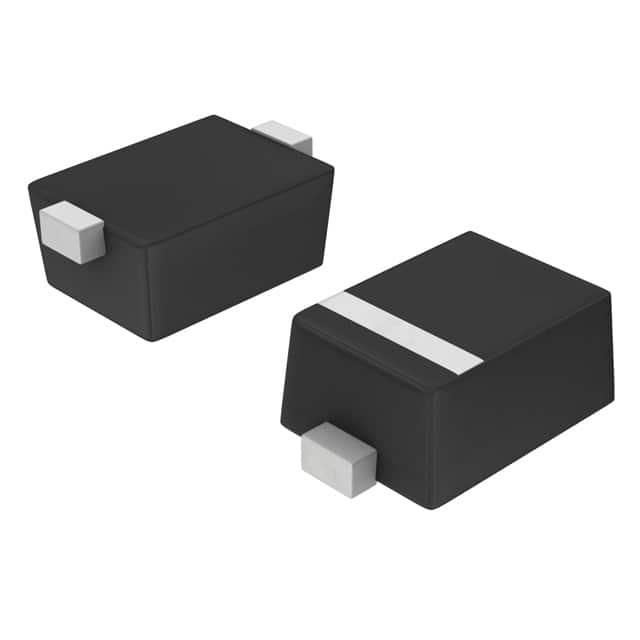Viz Specifikace pro podrobnosti o produktu.

NSR0620P2T5G Product Overview
Introduction
The NSR0620P2T5G is a semiconductor product belonging to the category of Schottky diodes. This component is widely used in electronic circuits for its unique characteristics, and it comes in a specific package with essential features that make it suitable for various applications.
Basic Information Overview
- Category: Schottky Diode
- Use: Rectification and voltage clamping in electronic circuits
- Characteristics: Low forward voltage drop, fast switching speed, low leakage current
- Package: SOD-123FL
- Essence: High efficiency and reliability in rectification applications
- Packaging/Quantity: Available in reels of 3000 units
Specifications
- Forward Voltage Drop: 0.35V at 1A
- Reverse Voltage: 20V
- Maximum Continuous Forward Current: 1A
- Operating Temperature Range: -65°C to 150°C
Detailed Pin Configuration
The NSR0620P2T5G has a standard SOD-123FL package with two pins. The pin configuration is as follows: - Pin 1: Anode - Pin 2: Cathode
Functional Features
- Fast Switching Speed: Enables rapid response in electronic circuits.
- Low Forward Voltage Drop: Minimizes power loss and heat generation.
- Low Leakage Current: Ensures minimal current flow in reverse bias.
Advantages and Disadvantages
Advantages
- High Efficiency: Contributes to energy-saving designs.
- Compact Package: SOD-123FL package allows for space-efficient circuit layouts.
- Reliable Performance: Offers consistent operation in various conditions.
Disadvantages
- Limited Reverse Voltage: Not suitable for high-voltage applications.
- Sensitivity to Overcurrent: Requires protection against excessive current flow.
Working Principles
The NSR0620P2T5G operates based on the Schottky barrier principle, where the metal-semiconductor junction provides low forward voltage drop and fast switching characteristics. When forward biased, it allows current to flow with minimal resistance, making it ideal for rectification purposes.
Detailed Application Field Plans
The NSR0620P2T5G finds extensive use in the following application fields: - Power Supplies: Used for rectification and voltage regulation in switch-mode power supplies. - Signal Clipping: Employed in audio and communication circuits for signal conditioning. - Reverse Polarity Protection: Integrated into electronic systems to prevent damage from reverse voltage.
Detailed and Complete Alternative Models
For users seeking alternative options, the following Schottky diodes can be considered: 1. BAT54C: Similar characteristics with a different package (SOT-23). 2. SS14: Higher reverse voltage rating (40V) with comparable forward voltage drop.
In conclusion, the NSR0620P2T5G Schottky diode offers efficient rectification and voltage clamping capabilities, making it a valuable component in various electronic applications.
[Word Count: 411]
Seznam 10 běžných otázek a odpovědí souvisejících s aplikací NSR0620P2T5G v technických řešeních
What is NSR0620P2T5G?
- NSR0620P2T5G is a Schottky diode, commonly used in electronic circuits for its low forward voltage drop and fast switching capabilities.
What are the typical applications of NSR0620P2T5G?
- NSR0620P2T5G is commonly used in power supply circuits, voltage clamping circuits, and reverse polarity protection circuits.
What is the maximum forward voltage drop of NSR0620P2T5G?
- The maximum forward voltage drop of NSR0620P2T5G is typically around 0.38V at a forward current of 1A.
What is the maximum reverse voltage rating of NSR0620P2T5G?
- The maximum reverse voltage rating of NSR0620P2T5G is 20V.
What is the typical reverse leakage current of NSR0620P2T5G?
- The typical reverse leakage current of NSR0620P2T5G is very low, usually in the range of microamps to nanoamps.
Can NSR0620P2T5G be used in high-frequency applications?
- Yes, NSR0620P2T5G is suitable for high-frequency applications due to its fast switching characteristics.
Is NSR0620P2T5G suitable for automotive applications?
- Yes, NSR0620P2T5G is often used in automotive electronics for functions such as reverse battery protection and voltage regulation.
What is the package type of NSR0620P2T5G?
- NSR0620P2T5G is typically available in a SOD-323 surface mount package.
Does NSR0620P2T5G require a heatsink in typical applications?
- No, NSR0620P2T5G is designed to operate without a heatsink in typical low to moderate power applications.
Are there any specific layout considerations when using NSR0620P2T5G in a circuit?
- It is important to minimize the length of traces between NSR0620P2T5G and other components to reduce parasitic inductance and ensure optimal performance.

